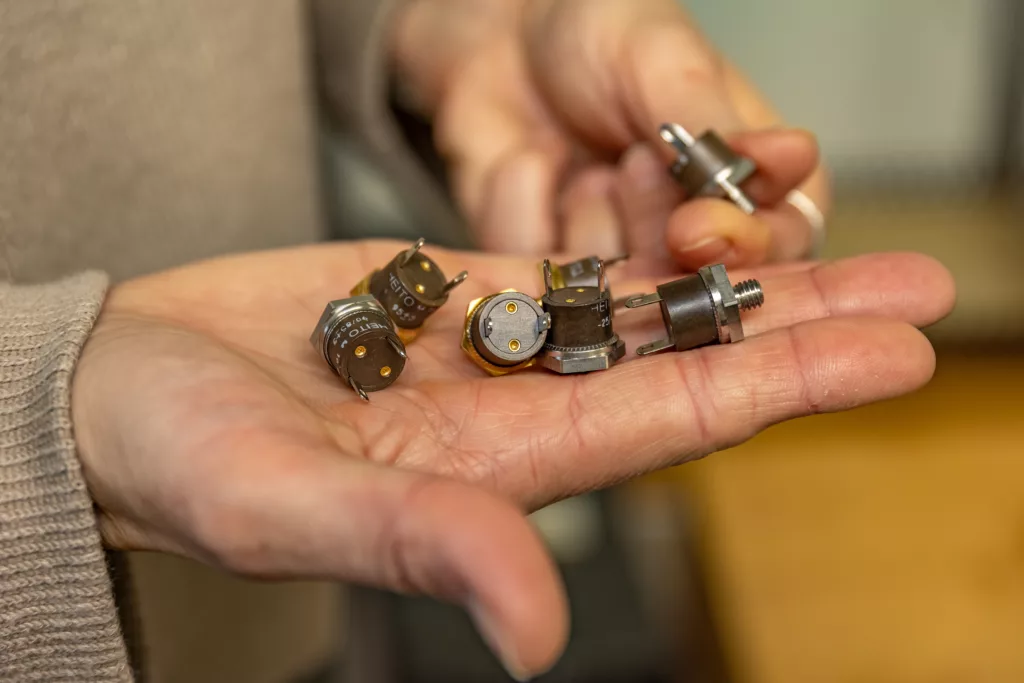
It’s essential to understand the difference between a bimetal thermostat and a conventional temperature sensor. A bimetallic thermostat is a switching device consisting of two metal strips that react differently to temperature variations. Operating without electronics, this system stands out for its robustness, reliability and long service life, with no loss of performance over time (Find out more about bimetal thermostats here : What is a bimetal thermostat).
In contrast, a conventional temperature sensor, such as a PT100 or PT1000 probe, measures temperature and converts this information into an electrical signal for processing by an external system. This type of sensor provides a continuous, precise temperature reading, whereas a bimetal thermostat simply triggers or interrupts an action in a circuit, at a precise instant, when the temperature exceeds a defined threshold.
Classic temperature sensor: precision, flexibility and connected technology
Conventional temperature sensors, whether PT100 and PT1000 probes, thermistors or thermocouples, are designed to measure temperature with great accuracy and transmit this data as electrical signals. This technology is particularly popular in modern systems requiring fine, scalable control.
The main advantage of these sensors is their ability to provide continuous information, which can be used by PLCs, microcontrollers or supervision systems. This makes it possible to improve servo-control with PID regulation, or to monitor data remotely for preventive maintenance purposes. They are also capable of operating over very wide temperature ranges, with adjustable levels of precision depending on the model, making them indispensable in the industrial, research or electronics sectors. Their integration flexibility and compatibility with connected systems make them ideal allies for scalable installations or complex environments.
Bimetal thermostat: simple, reliable and robust
In contrast to this electronic approach, the bimetallic thermostat is based on a purely mechanical principle: two metals welded together deform differently under the effect of temperature. Once a threshold is reached, this deformation causes an electrical contact to open or close.
The main advantage of this technology is its extreme simplicity. No need for a power supply, no signal to interpret, no control electronics: the thermostat acts directly on the circuit, making it totally autonomous and extremely reliable.
In addition to being economical and easy to install, the bimetal thermostat offers excellent durability. Resistant to shock, humidity, vibration and power failure, it is frequently used in simple appliances such as water heaters, radiators, ovens or motor thermal protection systems. The key to its reliability is that it always triggers at the right moment, and never when it shouldn’t, guaranteeing optimum safety. This reliability makes it particularly well-suited to critical systems, such as fire prevention systems or control systems for sudden temperature variations. The Heito range is renowned for its reliable triggering and rapid response.
Comparison of a single temperature sensor with a bimetal thermostat
| Criteria | Bimetal thermostat | Conventional temperature sensor |
| Operation | Mechanical (metal deformation) | Electronic |
| Cost | Low | High |
| Ease of installation | Direct connection | Complex : processing and action system |
| Energy autonomy | Autonomous | Requires a power supply for the sensor |
| Response time | Instantaneous | Fast |
| Accurate | Very accurate | Very accurate |
| Robustness | Resistant to any environment | Fragile |
| Reliable | Does not fail, never triggers prematurely | Constrained by the reliability of electronic components |
| Typical use | Regulation “all or nothing”, detection of uncontrolled deviations | Measurement, display, proportional regulation |
Conclusion
Heito’s VIGITHERME bimetal thermostat is renowned for its reliability, robustness and ease of integration into industrial systems. This component enables an electrical circuit to be switched on or off at a defined temperature, without any electronics, making it autonomous and inexpensive.
Thanks to its automatic or manual reset options, the bimetal thermostat is perfectly suited to the constraints of demanding sectors such as defense, aeronautics, medical or energy. Its compact design and direct switching system make it easy to integrate into complex systems.
Note that bimetal thermostats operate in all-or-nothing mode, unlike conventional sensor thermostats, which offer progressive regulation and remote supervision. Each solution has its own advantages, depending on the application, but the mechanical reliability of the Heito bimetal thermostat makes it an essential choice for guaranteeing the thermal safety of your equipment.
 FRANçAIS
FRANçAIS DEUTSCH
DEUTSCH